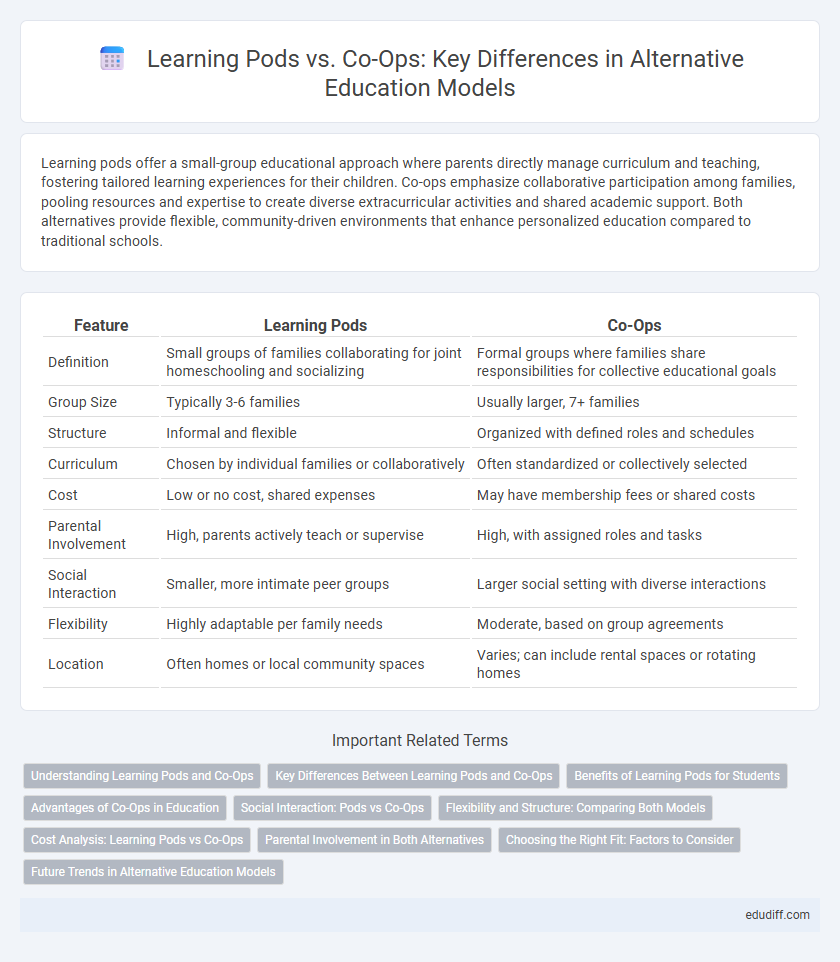Learning pods offer a small-group educational approach where parents directly manage curriculum and teaching, fostering tailored learning experiences for their children. Co-ops emphasize collaborative participation among families, pooling resources and expertise to create diverse extracurricular activities and shared academic support. Both alternatives provide flexible, community-driven environments that enhance personalized education compared to traditional schools.
Table of Comparison
| Feature | Learning Pods | Co-Ops |
|---|---|---|
| Definition | Small groups of families collaborating for joint homeschooling and socializing | Formal groups where families share responsibilities for collective educational goals |
| Group Size | Typically 3-6 families | Usually larger, 7+ families |
| Structure | Informal and flexible | Organized with defined roles and schedules |
| Curriculum | Chosen by individual families or collaboratively | Often standardized or collectively selected |
| Cost | Low or no cost, shared expenses | May have membership fees or shared costs |
| Parental Involvement | High, parents actively teach or supervise | High, with assigned roles and tasks |
| Social Interaction | Smaller, more intimate peer groups | Larger social setting with diverse interactions |
| Flexibility | Highly adaptable per family needs | Moderate, based on group agreements |
| Location | Often homes or local community spaces | Varies; can include rental spaces or rotating homes |
Understanding Learning Pods and Co-Ops
Learning pods are small groups of students who collaborate to enhance personalized learning experiences outside traditional classrooms, often led by parents or tutors. Co-ops, or cooperative homeschooling groups, combine resources and teaching responsibilities among families to provide a structured curriculum and social interaction. Both alternatives foster community-based education but differ in organization, scale, and instructional roles.
Key Differences Between Learning Pods and Co-Ops
Learning pods typically consist of small groups of families pooling resources to provide personalized, in-home education tailored to their children's needs, while co-ops are larger, community-based organizations offering structured classes and group activities with a curriculum led by parents or hired educators. Learning pods often emphasize flexibility and individualized instruction, whereas co-ops prioritize collaboration, shared responsibility, and diverse social interaction among participants. The key distinctions lie in scale, instructional approach, and the degree of parental involvement in management and teaching roles.
Benefits of Learning Pods for Students
Learning pods offer personalized instruction tailored to students' individual learning styles, enhancing engagement and academic success. They create a close-knit social environment that fosters collaboration, communication, and peer support among participants. Flexibility in scheduling and curriculum allows students to explore interests and advance at their own pace, promoting deeper understanding and motivation.
Advantages of Co-Ops in Education
Co-Ops in education offer significant advantages by fostering collaborative learning environments where students actively participate in group projects, enhancing critical thinking and social skills. These structured programs often provide access to diverse resources and expert guidance, promoting personalized instruction tailored to individual learning styles. The emphasis on shared responsibility in Co-Ops cultivates accountability and prepares students for real-world teamwork and professional settings.
Social Interaction: Pods vs Co-Ops
Learning pods offer small, consistent group settings that foster deeper peer connections and personalized social interaction, while co-ops provide larger, more diverse groups encouraging broader social networks and varied collaborative experiences. Pods typically enhance close-knit relationships due to limited group size, promoting frequent and meaningful interactions among participants. Co-ops emphasize collective activities and shared responsibilities, supporting diverse social dynamics and community engagement beyond immediate peers.
Flexibility and Structure: Comparing Both Models
Learning pods offer greater flexibility by allowing families to tailor schedules and curricula to individual student needs, promoting personalized learning environments. Co-ops provide more structured frameworks with predefined roles and responsibilities, ensuring consistent accountability and collaborative teaching efforts among parents. Both models support alternative education but differ in balancing adaptability with organized group dynamics.
Cost Analysis: Learning Pods vs Co-Ops
Learning Pods typically incur lower costs as expenses are shared among fewer families compared to Co-Ops, which often require more substantial financial contributions for facility rentals and professional educators. Co-Ops may offer a broader range of resources and structured curriculum, but this comes with increased collective fees and administrative costs. Families seeking affordable, flexible educational collaboration often find Learning Pods more cost-effective than traditional Co-Op models.
Parental Involvement in Both Alternatives
Learning pods and co-ops both emphasize high levels of parental involvement, but the dynamics differ significantly. In learning pods, parents often take on direct instructional roles, tailoring lessons to their children's specific needs and providing individualized support. Co-ops typically involve parents sharing teaching responsibilities and administrative tasks collaboratively, fostering a community-based approach to education.
Choosing the Right Fit: Factors to Consider
When choosing between Learning Pods and Co-Ops, consider the group's size, educational goals, and flexibility in scheduling to ensure alignment with your child's needs. Learning Pods often offer smaller, more personalized settings that emphasize collaborative learning, while Co-Ops provide structured curricula and shared teaching responsibilities among parents. Evaluating factors such as socialization opportunities, cost, and commitment level helps determine the best alternative education model for your family.
Future Trends in Alternative Education Models
Future trends in alternative education models spotlight the rising popularity of learning pods and co-ops as personalized, community-driven solutions. Learning pods offer small, focused groups that enhance peer interaction and tailor curriculum delivery, while co-ops emphasize shared teaching responsibilities and resource pooling among families. Innovations in digital tools and hybrid formats are accelerating adoption, making these models adaptable to diverse learning needs and promoting greater parental involvement in education.
Learning Pods vs Co-Ops Infographic

 edudiff.com
edudiff.com